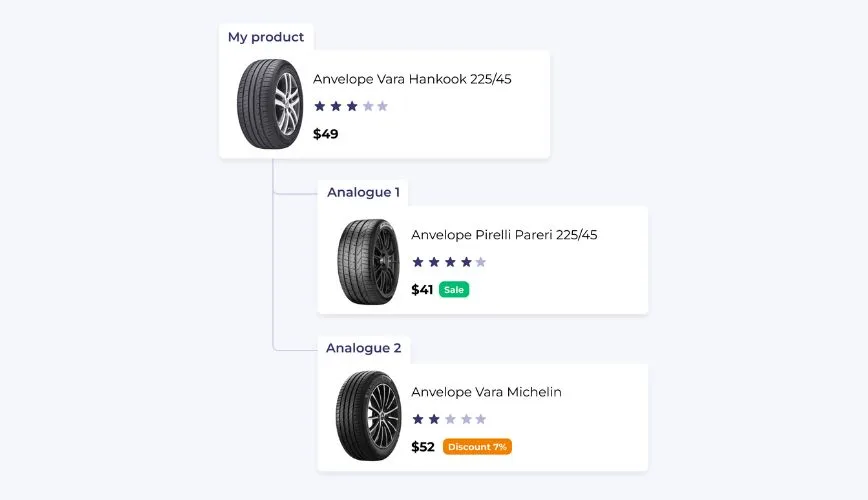Selecting the best pricing strategy is one of the most crucial aspects of managing an online business. If your e-commerce store operates in an industry with high levels of price fluctuation, demand, and competition, dynamic pricing may be your preferred strategy.
This article will guide you through the role of dynamic pricing in retail, factors fueling its popularity, and the advantages it offers.
Contents:
What Is Dynamic Pricing?
Dynamic Pricing in Retail
What Factors Contribute to the Rising Popularity of Dynamic Pricing in Retail?
Advantages of Dynamic Pricing for Businesses
When Should You Implement Dynamic Pricing?
What Is the Process for Implementing Dynamic Pricing?
Popular Dynamic Pricing Strategies in 2025
What Is Dynamic Pricing?
Have you ever had to pay a different price for a taxi ride on the same route? Then you have encountered dynamic pricing: the higher the demand, the higher the fare.
Dynamic pricing is an approach when the price of a product changes in real time depending on various factors: supply and demand, exchange rates, geolocation of the buyer, etc.
In the case of taxi aggregators (like Uber), factors that will immediately affect the price include the time of day, number of orders, traffic congestion, and weather conditions.
The price of a hotel room will also change depending on the season: the more popular the destination, the more you have to pay.
Similarly, an internet service provider can offer new customers more attractive terms than existing subscribers. Although in this case, the reduced rate is usually valid only for a certain time.
The main goal of dynamic pricing is to constantly offer a competitive price that includes the maximum possible profit for the business, taking into account the market situation.
Dynamic Pricing in Retail
Global giants such as eBay and Amazon use competitor price monitoring and various dynamic pricing methods to achieve two goals: attract as many customers as possible and maximize profitability.
Amazon changes prices about 2.5 million times a day, which means the price of an individual item is reviewed every 10 minutes on average. E-retail leaders use pricing automation to optimize sales. While some customers may complain about this, it’s a strategy that has helped Amazon increase profits by 25%.
What Factors Contribute to the Rising Popularity of Dynamic Pricing in Retail?
Several key factors have contributed to the rising popularity of dynamic pricing in retail:
- Advanced data analytics tools assist in collecting and analyzing vast amounts of information in real time. A data-driven approach empowers pricing decisions by considering factors like consumer behavior, seasonal trends, inventory status, and competitor prices.
- Modern technologies, including automated tools with artificial intelligence and machine learning algorithms for product reassessment, help retailers efficiently implement dynamic pricing strategies.
- Increased price transparency for consumers. Comparing prices for a particular product takes only a few minutes, as all pricing information is available online. Consumers can easily compare offerings from different sellers using platforms like Google Shopping and Shopzilla. This is why retailers need to adapt their pricing strategies to maintain competitiveness.
Combined, these factors have contributed to the extensive implementation of dynamic pricing in retail. While implementing them requires investments, it provides valuable business benefits.
Advantages of Dynamic Pricing for Businesses
Dynamic pricing helps to:
- Increase revenue. According to McKinsey analysts, using dynamic pricing models can achieve sales growth of up to 5%.
- Attract more customers. Setting competitive prices based on current market conditions will ensure that you attract new customers and increase the loyalty of existing ones.
- Stimulate interest in certain products. This approach also works as a means of influencing customer behavior and helping customers assess demand. If a customer is watching the price of certain products on e-commerce platforms and sees prices increasing, this can boost interest and encourage them to buy.
Choose the most profitable strategy. Based on accurate and up-to-date market data, you can create pricing strategies to achieve various goals: increase revenue, increase sales, effectively sell slow-moving inventory, and more.
When Should You Implement Dynamic Pricing?
You should implement dynamic pricing when you want to quickly and automatically change prices on a site with a large number of SKUs, taking into account certain external and internal factors:
- Competitors’ prices, sales, and promotions
- Prices of similar products
- Expected conversion rates
- Logistics and marketing costs
- Product shortages in the market (to increase margins for products that are in demand and only you have)
- Product stock levels
- Exchange rate fluctuations
- Margin levels and price floors
- Product shelf life, etc.
Pricer24 allows you to automate pricing and scale the most effective strategies for all product categories, even with a small number of category managers. With Pricer24, you will be able to:
- set individual rules and parameters for each category
- consider competitor prices and other parameters in addition to those mentioned above
- set up the parameters you want to monitor and those you want the system to visually indicate so that you can adjust your strategy
- get prices via API or integrate Pricer24 with your website.
What Is the Process for Implementing Dynamic Pricing?
If you are planning to implement dynamic pricing, you should start with the following steps:
1. Define your pricing objective.
Determine the commercial outcome your dynamic pricing model will target, which could include goals such as market capture, increased market share, profit maximization, or inventory management optimization.
2. Establish KPIs and monitor indicators of potential risks.
Your KPIs may include growing revenue and maintaining or increasing profits. In addition to these benchmarks, set monitoring indicators to mitigate potential risks associated with implementing dynamic pricing. These indicators may encompass:
- Threshold values for price elasticity
- Acceptable price differences compared to competitors
- Minimum acceptable profit margin
- Frequency of price adjustments
- Threshold for pricing-related customer complaints
3. Choose a dynamic pricing strategy.
Your pricing strategy should align with your business goals and market dynamics.
4. Define rules for dynamic pricing:
- Product categories for which dynamic pricing will be implemented
- Factors triggering price adjustments in each category (competitor prices, market product shortages, inventory availability, currency exchange fluctuations, margin and minimum prices, product shelf life, etc.)
- Rules (algorithms) for repricing products in each category based on selected factors
- Individual rules at the product level for bestsellers and other exceptions
5. Select a dynamic pricing tool.
When choosing dynamic pricing software, make sure its key features meet your business needs. These features can include:
- Configurable pricing strategies
- Real-time data transmission from various sources
- Competitor price tracking and analysis
- Algorithms for calculating optimal prices based on your strategy and available data
- Rule-based pricing that allows you to set predetermined conditions and pricing rules for different products or categories
- Rule adjustments
- Integration with e-commerce platforms
- Visual reports for data-driven decision-making
- Customer support and training
- Scalability options
Pricer24’s Dynamic Pricing tool offers all these key features, helping clients optimize pricing strategies for maximum success.
Popular Dynamic Pricing Strategies in 2025
The strategies described below can be combined to meet the specific goals of your business:
Demand-based pricing: Set higher prices during periods of high demand and reduce them during periods of low demand
Time-based pricing: Adjust prices according to the time of day, day of the week, or season
Competitor-based pricing: Take competitors’ prices as the basis for establishing one’s own prices
Dynamic discounts and flash sales: Offer temporary discounts or special offers to stimulate sales for a short period
Personalized pricing: Provide individual prices for specific customers based on their purchase history, behavior, and other personal factors
AI-driven dynamic pricing: Use AI to analyze large volumes of data and determine the best prices in real time
Bundling and combining products: Combine several products into one package and offer the package at a reduced price compared to purchasing each product separately
Event-based pricing: Adjust prices based on specific events, promotions, or holidays
Conclusion
Dynamic pricing plays a crucial role in today’s e-commerce, enabling retailers to promptly adjust their prices according to market needs and competitor actions, ultimately maximizing their financial outcomes.
Automated price monitoring and dynamic pricing tools help optimize the repricing of items, streamlining pricing strategies to enhance profits even with a limited team of category managers.
FAQ
What is dynamic retail pricing?
Dynamic pricing in retail adjusts product prices in real time based on factors like demand, competition, and customer behavior, optimizing prices to maximize revenue while staying competitive.
What is an example of dynamic pricing in retail?
Amazon’s pricing strategy is an example of dynamic retail pricing. Amazon actively monitors competitors’ prices and uses this data to dynamically adjust its own prices. Furthermore, Amazon uses algorithms that consider various factors, including not only information about competitors but also price history, demand, seasonality, and consumer behavior.
What is the difference between variable and dynamic pricing?
Variable pricing typically involves setting different prices for various customer segments or based on specific product attributes. In dynamic pricing, price adjustments take place in real time, guided by current market conditions, fluctuations in demand, or competitors’ pricing strategies.
What is price elasticity of demand?
Price elasticity of demand (PED) assesses the sensitivity of customers to price changes. If demand undergoes significant changes in response to price adjustments, it indicates high elasticity, whereas minimal changes in demand suggest low elasticity. PED assists retailers in understanding consumer behavior when establishing prices.









